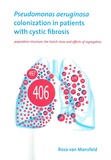Pseudomonas aeruginosa colonization in patients with cystic fibrosis
population structure, the Dutch clone and effects of segregation
Summary
More than half of the patients with cystic fibrosis (CF) are infected with Pseudomonas aeruginosa in their lungs. It was thought that patients acquired unique strains of this bacterium from the environment, however in the last decades epidemic clones have been described in other countries that are most likely transmitted between CF patients. Infection with these epidemic clones has been associated with worse clinical outcome. To prevent transmission of such clones a strict segregation policy was implemented in the Netherlands without extensive knowledge of the local epidemiology. CF patients are advised not to meet, are isolated from other patients when visiting the out-patient clinic or when hospitalized and events like summer camps were discontinued. This thesis describes the population structure of P. aeruginosa as highly diverse and highly specific for different patient populations. In CF patients two dominant genotypes are described, ST406 and ST497, that are associated with specific age groups and are different from the epidemic genotypes found abroad. The epidemic strains described abroad are not found in Dutch CF patients. ST406 is harbored by 50% of CF patients between 15 and 25 years of age in 2007 and ST497 was detected mainly in older CF patients. ST406 is not associated with worse clinical outcome, but appears resistant to more antibiotic classes than unique strains and is associated with more inhaled antibiotic therapy. High persistence and possibly ease of transmission seem to have contributed to its spread. Investigating the genome, transcriptome and phenotypic features of two ST406 strains cultured from the same patient with three years in between demonstrated that ST406 is a slow growing, low virulent strain and adaptation to the CF lung niche was driven mostly by point mutations that coincided with differences in transcriptome levels and phenotypic changes, most notably with differences in biofilm formation. Some of the adaptations found in ST406 were also described for other chronic CF related strains, indicating parallel evolution of different P. aeruginosa strains to the CF lung niche. These affected genes might provide targets for future therapies. Evaluating the effect of five years of segregation in the Netherlands yielded little difference in P. aeruginosa population structure and no statistically significant difference in acquisition of chronic infection. However, in post-hoc analysis there was a significant difference in chronic acquisition in young patients (under 15 years of age). Also there were no new acquisitions with ST406 in the newly infected patients during segregation. These findings suggest that continuing with strict segregation reduces the acquisition of chronic infection at least in young CF patients as well as the spread of shared genotypes that are associated with resistance to more antibiotic classes.
